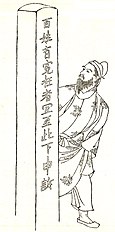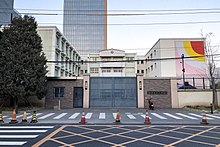Japanese people in China

| Total population | |
|---|---|
| Mainland China: 171,763 (2018) Hong Kong: 27,429 (2018)[1]note Macau: 4,200 (2018)[2] Taiwan: 24,280 (2018)[3] | |
| Regions with significant populations | |
| Beijing · Suzhou · Shanghai · Guangzhou · Hong Kong · Macau · Taipei · Kaohsiung | |
| Languages | |
| Japanese · Mandarin · Cantonese · Hokkien · English | |
| Religion | |
| Buddhism · Shinto | |
| Related ethnic groups | |
| Japanese people in Hong Kong |
| Japanese people in China | |||||||||
|---|---|---|---|---|---|---|---|---|---|
| Chinese name | |||||||||
| Traditional Chinese | 日裔中國人 | ||||||||
| Simplified Chinese | 日裔中国人 | ||||||||
| |||||||||
| Japanese name | |||||||||
| Kanji | 在中日本人 | ||||||||
| |||||||||
Japanese people in China (Japanese: 在中日本人, Chinese: 日裔中國人, also known as Japanese-Chinese or Sino-Japanese) are Japanese expatriates and emigrants and their descendants residing in Greater China. In October 2018, there were 171,763 Japanese nationals living in the People's Republic of China (excluding the special administrative regions of Hong Kong and Macau), and 24,280 Japanese nationals living in the Republic of China (Taiwan).[3]
History
[edit]
From 630 to 894 AD, Japan sent nineteen diplomatic missions to China started by Emperor Jomei. During this time, many Japanese doctors studied Traditional Chinese Medicine, as well as many artists learning Chinese art techniques that would be brought to Japan. It is known that a third of the Japanese sent to China during missions did not return home. Tang dynasty China received 11 Japanese dancers as tribute from Balhae in year 777.
Second Sino-Japanese War
[edit]During the Second Sino-Japanese War, the Japanese government introduced a plan to settle 5 million Japanese in Manchukuo. However, following the end of the war, approximately 2,800 Japanese orphans in China were left behind by families repatriating back to Japan.[4]
The majority of Japanese left behind in China were women, and these Japanese women mostly married Chinese men and became known as "stranded war wives" (残留婦人, zanryū fujin).[5] Because they had children fathered by Chinese men, the Japanese women were not allowed to bring their children back with them to Japan so most of them stayed, as the Japanese law only allowed children fathered by Japanese men to become Japanese citizens.
21st century
[edit]In 2000s, more Japanese were coming to China due to its opening up and economic reforms, and Japanese nationals living in China increased roughly three times from 46,000 to 140,134 in proportion to the growth in trade volume between the two countries.[6][7]
The 2010 Census of the People's Republic of China recorded 66,159 foreign nationals from Japan residing in Mainland China (figure excluding Hong Kong and Macau),[8] representing nearly half of the Japanese Foreign Affairs Ministry figure. The number of Japanese emigrants to China and their descendants are unknown.[9][6] However, the peak was 2012 and recently decreasing.[9] In 2018, the permanent resident ratio is only 2.7%.[9]
As of October 2018, the number of Japanese nationals living in China is 140,134 (excluding 25,705 in Hong Kong and 4,200 in Macau) according to a report by the Japanese Ministry of Foreign Affairs, the third largest group of Japanese people outside Japan after the United States and Brazil.[9]
Graphs are unavailable due to technical issues. There is more info on Phabricator and on MediaWiki.org. |
Shanghai has the largest concentration of Japanese nationals in Greater China.[9][10] As of October 2018, 40,747 Japanese nationals are living in Shanghai.[9] The second-largest concentrated city is Hong Kong and the third is Taipei.[9]
Education
[edit]

The following are approved by the Japanese Ministry of Education (MEXT):
- Full-time nihonjin gakko:[11]
- Beijing: Japanese School of Beijing
- Guangdong
- Jiangsu: Suzhou Japanese School
- Liaoning: Dalian Japanese School
- Shandong: Qingdao Japanese School (青島日本人学校)
- Shanghai: Shanghai Japanese School
- Tianjin: Tianjin Japanese School (天津日本人学校)
- Zhejiang: Hangzhou Japanese School (杭州日本人学校)
- Supplementary Japanese language education programs (hoshu jugyo ko or hoshuko):[12]
- Guangdong:
- Shenzhen Saturday School (深圳(シンセン)補習授業校 Shinsen Hoshū Jugyō Kō, formerly SHENZHEN日本人補習校) – Office on the 8th floor of the Jinsanjiao Building (金三角大厦/金三角大廈) in Baishizhou, Nanshan District.[13] Previously based in the Ming Wah International Convention Centre (明华国际会议中心) in Shekou.[14]
- Zhuhai Japanese Saturday School (珠海日本人補習校)[13] – classes at QSI International School of Zhuhai[15]
- Jiangsu:
- Nanjing Japanese Saturday School (南京補習授業校 Nankin Hoshū Jugyō Kō) – Nanjing International School, Qixia District, Nanjing[16]
- Wuxi Japanese Saturday School (無錫(ムシャク)補習授業校 Mujaku Hoshū Jugyō Kō) – Wuxi New Area[17] – Established 14 April 2006[18]
- Liaoning: Shenyang Saturday School (瀋陽補習授業校 Shenyan Hoshū Jugyō Kō)[19] – It was established in April 2006 and is in Shenhe District, Shenyang[20][21]
- Zhejiang: Ningbo Saturday School (寧波(ニンボー)補習授業校 Ninbō Hoshū Jugyō Kō)[22]
- Guangdong:
- Former hoshuko:
- Jiangsu: Suzhou – Held at the Suzhou Foreign Language School (苏州外国语学校) in Suzhou New District[14]
- Shandong: Qingdao[14]
- Hong Kong Japanese School (nihonjin gakko)[11]
Unrecognized by MEXT:
- Chengdu Hoshuko (成都日本語補習校 Chentū Nihongo Hoshūkō) – Wuhou District, Chengdu,[24] established on 12 February 2012[25][26]
Notable people
[edit]- Chinese people of Japanese descent
- Chiang Wei-kuo (originally from Tokyo)
- Hiro Saga – wife of Prince Pujie, brother of the Emperor Puyi (originally from Tokyo)
- Huisheng & Husheng – half-Japanese princesses of the Qing ruling family
- Jiang Ying – renowned opera singer and music educator
- Koxinga – Ming dynasty general
- Zheng Pingru – socialite and spy who gathered intelligence on the Imperial Japanese Army
- Japanese expatriates in China
- Chikada Rikimaru, Mika Hashizume, and Santa Uno – members of Into1
- Chikada Rikimaru (originally from Itami, Hyōgo)
- Mika Hashizume – Japanese American
- Santa Uno (originally from Nagoya, Aichi)
- Ken'ichi Miura (三浦 研一, Miura Ken'ichi) – Japanese actor in China (originally from Edogawa-ku, Tokyo)
- Ryo Takeuchi – film director (originally from Abiko, Chiba)
See also
[edit]References
[edit]- ^ 海外在留邦人数調査統計 [Annual Report of Statistics on Japanese Nationals Overseas] (PDF). Ministry of Foreign Affairs of Japan (in Japanese). 1 October 2010.
- ^ "Macau Population Census". Census Bureau of Macau. May 2012. Retrieved 22 July 2016.
- ^ a b Ministers for Foreign Affairs of Japan
- ^ "Forgotten plight of foster parents". Xinhua News. 22 April 2005. Archived from the original on 12 October 2012. Retrieved 30 November 2007.
- ^ "Left Behind: Japan's Wartime Defeat and the Stranded Women of Manchukuo". Archived from the original on 12 January 2016. Retrieved 21 May 2015.
- ^ a b Kyung Lah, 12 November 2010, Twin Tale: Rising China, Japan's setting sun, CNN
- ^ "《中国》【年別】(輸出)" [The volume of Import and Export to China]. Trade Statistics of Japan.
- ^ "Major Figures on Residents from Hong Kong, Macao and Taiwan and Foreigners Covered by 2010 Population Census". National Bureau of Statistics of China. 29 April 2011. Archived from the original on 14 May 2011. Retrieved 29 April 2011.
- ^ a b c d e f g h 海外在留邦人数調査統計 統計表一覧 | 外務省
- ^ "Japanese making Shanghai their home". CNN. 10 December 2010. Retrieved 29 November 2013.
- ^ a b "アジアの日本人学校一覧(平成26年4月15日現在)." Japanese Ministry of Education. Retrieved on 12 January 2017.
- ^ a b "アジアの補習授業校一覧(平成25年4月15日現在)" (). Ministry of Education, Culture, Sports, Science and Technology. Retrieved on 13 February 2015.
- ^ a b "日本人学校・補習授業校一覧." Consulate-General of Japan in Guangzhou (在広州日本国総領事館/日本国驻广州总领事馆). Retrieved on 21 December 2017. "深セン日本人補習校 518052 広東省深圳市南山区白石洲金三角大廈8階" and "広東省 珠海市 珠海日本人補習校 519000 広東省珠海市吉大石花西路161号(珠海藤倉電装有限公司内)"
- ^ a b c "アジアの補習授業校一覧" (). MEXT. 2 January 2003. Retrieved on 7 April 2015. "青島 青島市彰化路銀都花園T5-2" and "蘇州 蘇州日本人補習授業校 (連絡先) 中華人民共和国江蘇省蘇州市新区獅山路16号金獅大厦10D住友銀行蘇州支店 (所在地) 中華人民共和国江蘇省蘇州市新区金山路118号蘇州外国語学校内" and "カルカタ 休 校 中" and "中華人民共和国広東省SHENZHEN市蛇口工業區亀山路8號「明華国際会議中心」"
- ^ "アジアの補習授業校一覧(平成25年4月15日現在)" (). Ministry of Education, Culture, Sports, Science and Technology. Retrieved on 13 February 2015. "チェンナイ Japanese School Educational Trust of Chennai Inside American International School Chennai, 100 Feet Road, Taramani, Chennai, 600113, INDIA" "南京 Nanjing Japanese Saturday School 中華人民共和国南京市栖霞区仙林大学城 学衝路8号 南京国際学校内" and "珠海 広東省珠海市拱北九州大道西2001号 恒信工業区「QSI International School of Zhuhai」内"
- ^ "学校案内." Japanese Weekend School of Nanjing. Retrieved on 1 April 2015. "所在地 南京国際学校(NIS)"
- ^ "Home" (). Wuxi Japanese Saturday School. 8 April 2008. Retrieved on 2 April 2015. "所在地:無錫市新区行創四路88号 無錫国際学校国際部"
- ^ "無錫日本語補習授業校" (Archive). Wuxi Japanese Saturday School. Retrieved on 3 April 2015. "開校日: 2006年4月14日" and "住所: 無錫市新区行創四路88号 無錫東方国際学校内 無錫日本語補習授業校"
- ^ Home page Archived 22 February 2015 at the Wayback Machine. Shenyang Hoshuko. Retrieved on 31 March 2015. Old URL.
- ^ "学校概要 Archived 2016-03-04 at the Wayback Machine." Shenyang Hoshuko. Retrieved on 31 March 2015. "所在地 小書童教育連鎖機構瀋陽文芸路学習中心内(瀋陽市文芸路地王国際花園10号楼2号)"
- ^ "沈阳市组织机构代码管理办公室" (Archive). National Administration to Code Allocation to Organizations (NACAO; 全国组织机构代码管理中心). Retrieved on 1 April 2015. "沈阳市沈河区五爱街2号(地王国际花园东裙楼)"
- ^ Home page. Ningbo Saturday School. Retrieved on 31 March 2015.
- ^ "Home." Hong Kong Japanese Supplementary School. Retrieved on 14 February 2015.
- ^ "学校施設." Chengdu Hoshuko. Retrieved on 1 April 2015. "成都日本語補習校は、成都市内にある広島・四川中日友好会館の一室をお借りして授業を行っています。" and "成都日本語補習校四川省成都市武候嗣盛隆街9号"
- ^ "学校概要." Chengdu Hoshuko. Retrieved on 1 April 2015.
- ^ "学校施設." Chengdu Hoshuko. Retrieved on 1 April 2015.

